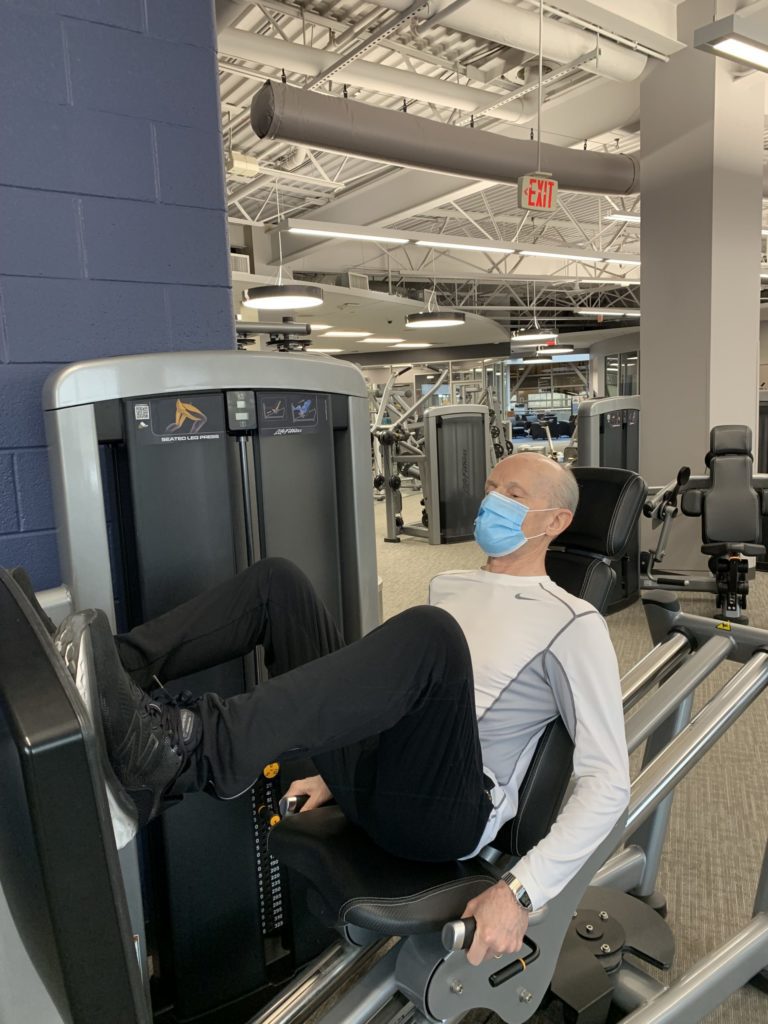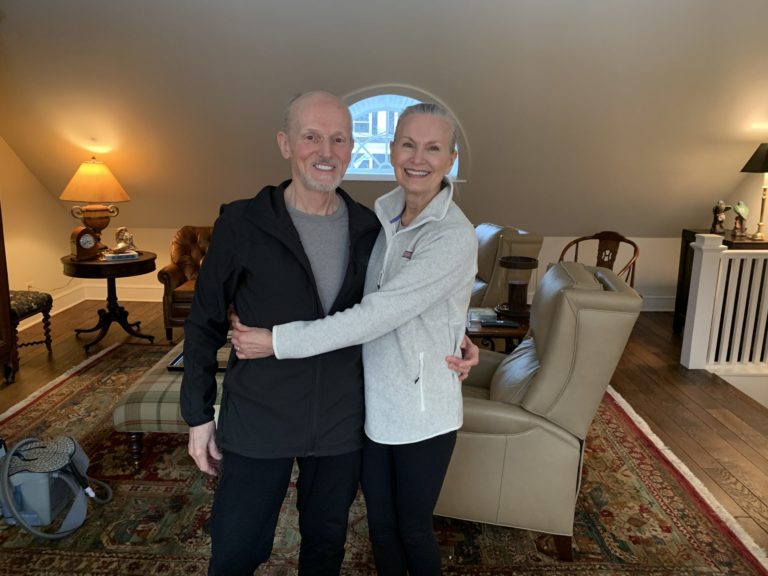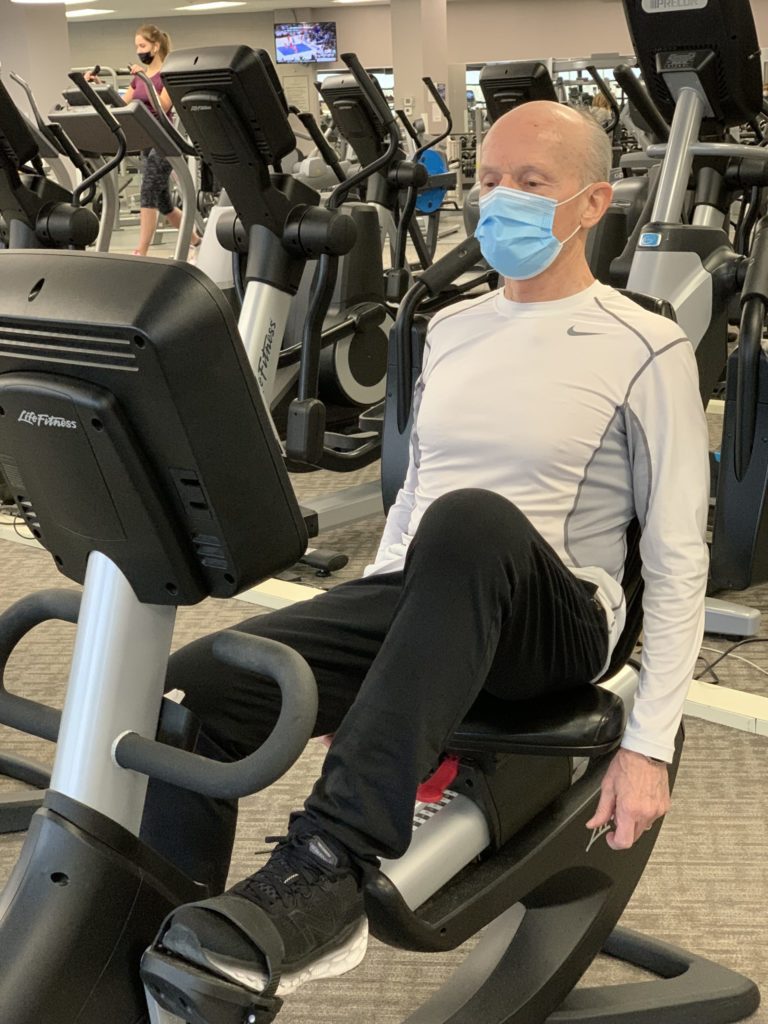After years of knee pain, robotic knee replacement surgery was the permanent solution George needed to treat his osteoarthritis.
At age 72, the discomfort in George’s knees had been going on for many years due to osteoarthritis. After multiple shots in each knee, which temporarily solved his pain problems, it was time for a permanent solution—knee replacement surgery performed by Sean Sutphen, DO.
“I lived with the pain as long as I could,” George says. “You can only take so many NSAIDs. I couldn’t go on like this.”
Read on to discover why knee replacement was the solution for both of George’s knees and why he’s happy he chose IBJI for knee care.
What Is Robotic Knee Replacement?
With robot-assisted total knee replacement, Dr. Sutphen uses an MRI to make a virtual 3D model of a patient’s knee, enabling him to establish a much more accurate preoperative plan.
He guides the robotic-arm during the procedure to ensure precise bone cuts and precise positioning of replacement implants. It allows a more customized planned surgery for each patient.
“What the robot allows us to do is to take into account the patient’s anatomy, soft tissue structures, and customize the surgery for them,” Dr. Sutphen says.
Studies show that robotic knee replacement surgery has the potential for:
- Faster recovery time
- Fewer scars from surgery
- Less postoperative pain
- Not as much blood loss during surgery
- Better long-term results with improved mobility
Why George Needed a Knee Replacement
George has been active his entire life and spent his career as a medical exercise specialist and director of a health club in Chicago. He is familiar with post-op patients who are just like him, recovering from surgeries like robotic knee replacement.
“My medical exercise specialist certification allowed me to work with people who had surgery, taking over their rehab once their physical therapy ran out,” George explains.
About eight years ago, George had meniscus surgery on his left knee, at which time his doctor also discovered that he had severe osteoarthritis. An MRI revealed he had it in both knees. This news led him down the path toward robotic-assisted total knee arthroplasty.
“After my meniscus surgery on my left knee, arthritis worsened, and eventually my right knee became worse than my left knee,” George recalled.
Non-Surgical Treatments for Knee Pain
Before considering robotic knee replacement, George turned to three different kinds of hyaluronic acid injections and two kinds of cortisone shots. “Nothing worked permanently, and even hardly temporarily,” George said. “When you have arthritis, it just doesn’t get better.”
Like many people, George coped with excruciating knee pain by taking over-the-counter pain medication like ibuprofen. But the non-steroid anti-inflammatory drugs were taking a toll on his digestive system. “I started having problems with an ulcerative colon,” George said. “I had to stop taking all kinds of NSAIDs.”

George regularly exercises at a fitness center near his home.
Why George Chose Robotic Knee Replacement
Before knee replacement surgery, George had difficulty with mobility in his home. Even walking became difficult from a pain standpoint. Both knees were painful almost every moment of the day and night.
He remembers the pain being horrible whenever he tried to go up or down the stairs. Getting in and out of the car was equally painful, and he had to give up running, one of his favorite activities.
“Almost anything I did throughout the day unless my legs were supported by a reclining chair would be painful. They were painful when sitting, bent, flexed, or extended. The pain would wake me up when I was sleeping.”
Knee pain can start mild but ramp up to an unbearable level in a short amount of time. It’s a common reason why a patient schedule online with an orthopedic surgeon.
George noticed that the pain was increasing over time. Before his robotic knee replacement, George rated the level, based on the universal pain scale, to be an eight out of ten on his right knee and a seven out of ten on his left.

George and his wife Karen are all smiles following his robotic knee replacement surgeries.
Finding the Best Surgeon for Robotic Knee Replacement
It was spring 2021 when George decided to get a recommendation for a surgeon who could perform knee replacement surgery.
“I asked if my internist knew of someone in Highland Park because I really couldn’t stand the pain in my knees anymore,” George said. “He said that Dr. Sean Sutphen had a great reputation and that I should go talk to him.”
As soon as George made the call, he was able to schedule online the following week at the IBJI Bannockburn Doctors’ Office.
“I can tell you that the first visit was amazing,” George said. “Sometimes you know in the first second you meet somebody that you like them. As soon as he walked in the door and introduced himself, I could tell he was a nice guy. He was so confident, interested in my problems, asked questions, and explained things to me. He mentioned the robotic knee replacement and explained it. I knew I wanted to have it done.”

Working out after robotic knee replacement surgery is
easy for George.
George’s First Knee Replacement Surgery
About four to six weeks later, George had his right knee done.
“I was expecting horrible pain post-op, but I didn’t get that at all,” he recalls. “It was quite tolerable, and of course, I didn’t feel anything for the first 24 hours due to the pain block.”
By the time George left the hospital, he was feeling pretty good. He was completely off all pain medication within three to five days with each robotic knee replacement.
“I iced my knees, and the pain wasn’t bad,” George said. “I was probably so used to severe pain that this seemed like nothing.”
Knee Replacement Recovery
George’s expertise in rehab was an asset to his knee replacement recovery.
“I knew what I was in for in physical therapy,” he says. “They made me work really hard, but I also like to do five times more than I’m told to do. That’s just me. As a result, I had a great outcome.”
George was asked to do knee extensions and flexion, calf raises, and marching, the latter of which he worked at raising his knees to the same height.
“Those things allow you not to use a walker or a cane very quickly,” he said. “I made sure, when I got home, to use the walker for one day and the cane for two, but then that was the end of that.”
By the time George started his outpatient rehab, he was walking without a cane, limp, or walker. Over two and a half months, he worked on getting his first knee to at least 80 percent healed so that Dr. Sutphen could perform the second robotic knee replacement on his left knee.
Dr. Sutphen allows 12-week intervals between first and second knee replacement surgeries. Since George put forth such effort with physical therapy sessions, he healed sooner and was ready for the second surgery.
George’s Second Robotic Knee Replacement
Just ten weeks after the first knee replacement, George had his second knee replacement surgery in October 2021.
“I couldn’t wait to get the second one done,” George says, adding that the upcoming winter weather had him concerned. “I didn’t want to be slipping on the ice with a brand new knee.”
The second robotic knee replacement surgery went just like the first one, except that George didn’t need a cane or walker at all this time.
“The physical therapist in the hospital said, ‘let’s use a cane,’” George recalled. “I walked out of the hospital with a cane and got out of the car with it, but I never used it in the house.”
Able to put weight on his left knee immediately, George attributes his ability to walk unaided to Dr. Sutphen’s expert surgical skills. “I really do credit Dr. Sutphen’s technique to my great recovery. I think he’s a wonderful surgeon. I can’t imagine anybody else being better at it.”
Doing What He Loves After Two Knee Replacement Surgeries
George is back to going to the fitness center near his home. He can walk without pain and ride a stationary bike, something he couldn’t do before, and he has added leg presses to his regular workout routine.
“It’s remarkable,” he says. “I don’t wake up because of pain in the middle of the night anymore, which is also fantastic.”
George can’t wait to try golfing again. He stopped doing it 15 years ago due to his knee pain. “I’m guessing that it will go quite well for me,” he says.
George’s message to others considering robotic knee replacement surgery is to go for it. “If they fear having surgery, at least with Dr. Sutphen, that fear is basically removed because of his perfection in what he does,” he says.
“You can almost be guaranteed that you’re going to have a great outcome, and everything is going to go back to normal for you faster than you think it will with much less pain than you probably would anticipate.”
Trust IBJI for Your Knee Care
We are experts in robotic knee replacement surgery. Our practice has more than 150 physicians at 100 locations in the Chicagoland area, with expertise in surgical and non-surgical treatments for chronic knee pain and other orthopedic specialties.




